I'm sorry to interrupt the Orthodox Christmas posts, but this is urgent and important. The General Congregation of the Society of Jesus is currently taking place in Rome.

Seal of the Society of Jesus. The "IHS" trigram comprises the first three Greek letters of "IHΣOYΣ" (Jesus), later interpreted as "Iesus Homini Salvator", Jesus, Saviour of Mankind and as "Iesum Habemus Socium", We have Jesus as Companion
 The Jesuit General Congregation is something extremely rare. Since their foundation almost 500 years ago, there have been, including this one, only 35 such General Congregations attended by delegates who represent the whole body of the Society.
The Jesuit General Congregation is something extremely rare. Since their foundation almost 500 years ago, there have been, including this one, only 35 such General Congregations attended by delegates who represent the whole body of the Society.A general congregation is the ultimate governing body of the Society when it is in session. Once the congregation begins, it alone can determine when it has completed its business, as there is no scheduled ending time. One of the reasons a General Congregation gathers is to elect a new General of the Society who usually holds the position for life and is known as the Black Pope. So, the act of electing a General is very important as he's in for life.
This GC is unique because the current Father General, Fr. Peter Hans Kolvenbach who succeeded Pedro Arrupe, SJ (who did much to transform the Jesuits from the formidable and loyal force it had been since its foundation by St. Ignatius into what it is today) has chosen to retire and has summoned the GC to, among other things, elect a new General.
It was during the twenty-seven year Generalate of Father Wlodzimierz Ledochowski (1915-1942) that the traditional character of the Society received the firmest stamp and clearest definition since the Generalate of Claudio Acquaviva in the sixteenth and seventeenth centuries. One might even say that Ledochowski insisted on fidelity to the structure of Jesuit obedience, was an almost merciless disciplinarian,and maintained a stream of instructions flowing out to the whole Society about every detail of Jesuit life and Ignatian ideals. He know exactly what Jesuits should be according to the Society’s Constitutions and traditions; and under strong hands of two quite authoritarian Popes, Pius XI and Pius XII, he reestablished the close ties that had once linked papacy and Jesuit Generalate. Ledochowski, in fact, gave renewed meaning to that old Roman nickname of the Jesuit Father General, “the Black Pope. Just as Pius XII can be described as the last of the great Roman Popes, so Ledochowski can be called the last of the great Roman Generals of the Jesuits.
There seemed, indeed, during those years of Ledochowski, Pope Pius XI, and Pius XII, no real limit to what both Jesuitism and overall Roman Catholicism could achieve. Even – especially, we should say – in the afterglow of Ledochowski’s long reign and into the Generalate of his successor, Belgian Jean-Baptise Janssens, the magic power of momentum seemed to continue. [Until Pedro Arrupe came along.]
 The Jesuits had, for many many years, been the greatest of missionaries and number St. Francis Xavier, the Apostle to the East, St. Isaac Joques (left) the Missionary of the American Indians and St. John Britto, the missionary to India among them. This is no longer true. The Jesuits have had a tremendous number of saints and martyrs. The Litany includes St. Ignatius himself, St. Stanislaus Kostka, St. John Berchmans, the Patron of Altar Servers, St. Peter Claver, St. Paul Miki, St. Peter Canisius, the great St. Robert Bellarmine, Doctor of the Church (below), St. Andrew Bobola, and St. Claude de La Colombière, the Apostle of the Devotion to the Sacred Heart. And special mention to one of my favourite saints, St. Edmund Campion and other Jesuits who died for the Faith in England. We pray that the modern Jesuits re-embrace this branch of the tradition of their illustrious order.
The Jesuits had, for many many years, been the greatest of missionaries and number St. Francis Xavier, the Apostle to the East, St. Isaac Joques (left) the Missionary of the American Indians and St. John Britto, the missionary to India among them. This is no longer true. The Jesuits have had a tremendous number of saints and martyrs. The Litany includes St. Ignatius himself, St. Stanislaus Kostka, St. John Berchmans, the Patron of Altar Servers, St. Peter Claver, St. Paul Miki, St. Peter Canisius, the great St. Robert Bellarmine, Doctor of the Church (below), St. Andrew Bobola, and St. Claude de La Colombière, the Apostle of the Devotion to the Sacred Heart. And special mention to one of my favourite saints, St. Edmund Campion and other Jesuits who died for the Faith in England. We pray that the modern Jesuits re-embrace this branch of the tradition of their illustrious order.The Jesuit universities and schools also had produced some of the brightest minds in the Church and have consistently defended Catholic teaching and the authority of the Roman Pontiff. Sadly, this is no longer universally true as well. The Jesuits of old were also fervent supporters and promoters of the Devotion to the Sacred Heart of Jesus. Let me know if you know of Jesuit priests and parishes who still adhere to this great devotion.
In his final years Janssens had to confront a dissension which was arising among theologians inside and outside the Society. He tried to moderate the problem, but to no avail, since the difficulty was not only within the Society, but also throughout the whole Church. He was the last to see the numbers in the Society top out at 36,000 members. After which high point there was a steady drop for the next thirty years.
 Many Jesuit priests have also been disciplined by Rome, among the latest, Jon Sobrino, SJ who espouses Liberation Theology.
Many Jesuit priests have also been disciplined by Rome, among the latest, Jon Sobrino, SJ who espouses Liberation Theology.The Jesuits are ageing and dying out in many places. Heterodoxy often results in this. No one is interested in committing their lives to being celibate social activists. Social activism in the married state is much for fun.
Personally, I don't think that the Jesuits can survive many more liberal Generals and keep on their current course without becoming irrelevant. Of course, as the history of the Church has shown, orders come and go and death and renewal includes religious orders. But what a waste it would be if this were to come to pass. It would be a monumental shame. The Society of Jesus was such a good idea.
At the thirty-first General Congregation (GC XXXI) of the Society of Jesus in 1965, he was elected the order's twenty-eighth Father General. He served in that position from 1965 to 1983. Father Vinnie O'Keefe, who was a great friend of Arrupe's as well as one of his top advisers, says Arrupe was "a second Ignatius, a refounder of the Society in the light of Vatican II." The defining moment of Fr. Arrupe's leadership of the Jesuits was probably the thirty-second General Congregation (GC XXXII), which he called in 1975.
Arrupe's dream was crystallized in the document (decree 4), Our Mission Today: the Service of Faith and the Promotion of Justice. Of GC XXXII. This decree basically defined all the Jesuits work as having an essential focus on the promotion of Justice as well as the Catholic Faith. This decree was so hotly debated that it was not voted on, until the very last day of the congregation, March 7, 1975. when it was accepted by an overwhelming majority of delegates. This focus on justice was to cause great conflict within the order, the church and also have remarkable consequences on the outside world.
On August 7, 1981, in the midst of his refounding of the Jesuit Order, Father Arrupe suffered a stroke just after his airplane had landed at Rome's Fiumicino Airport. He was paralyzed on his right side and was able to speak only a few words, but this ability gradually deteriorated until he was completely mute.
 Pedro Arrupe and his successor, the current Father General, Peter Hans Kolvenbach in the latest fashionable albubles/chalbs and overlay stoles of the 1970's.
Pedro Arrupe and his successor, the current Father General, Peter Hans Kolvenbach in the latest fashionable albubles/chalbs and overlay stoles of the 1970's.Now, don't get me wrong. I have nothing against the Society. I love it dearly. In fact, we have Jesuit novices from Singapore and East Timor visiting us at the Major Seminary now and I'm scheduled to take them sightseeing this Thursday. Last year, we played football with them and took them for a tour around Penang. I consider them dear friends. It's just that I'm sad that as a whole, the Society has moved so far from the spirit of it's founders. Perhaps a ressourcement is in order? I think that if the mission and spirit of St. Ignatius of Loyola and his Companions is once again embraced, by the grace of God and the intercession of the Blessed Virgin Mary and all the Jesuit saints, they would once again be a great force of good, for the evangelization of the Church, the world and the spread of the Gospel to the Glory of Jesus Christ.
Let us pray that when the Lord guides them, the Jesuits will have the openness of mind and heart to accept His guidance and be faithful to the Gospel of Jesus Christ and to the Church led by St. Peter's successor, the Pope to whom they have pledged obedience.
Pray for the Jesuits! Pray!
 The 226 members of the 35th General Congregation process into the Gesu (Jesus, in Italian) for the opening liturgy of the Congregation.
The 226 members of the 35th General Congregation process into the Gesu (Jesus, in Italian) for the opening liturgy of the Congregation.I advise you all to read carefully the excellent homily pronounced by Franc Cardinal Rode, the Prefect for the Congregation for Institutes of the Consecrated Life and Societies of Apostolic Life. It's really great and touches on important issues facing the Jesuits in particular and the Church as a whole today. I've taken the liberty to highlight the very important parts, but read the whole thing. It's well worth it. Know what sentire cum ecclesia is. It was the theme for the Malaysian Church last year. And yet, we are so far from thinking with the mind of the Church.
Cardinal Rode Exhorts Jesuits to Love Church [Andrew: And we pray that they listen to him!!]
All photos of the Mass and descriptions are by Fr. Don Doll, S.J. - Creighton University and are copyright to him. Source.
Calls for Religious Obedience Founded on Love
ROME, JAN. 7, 2008 (Zenit.org).- The Church is counting on the Society of Jesus to play a role in restoring the sense of Church among religious families, says a Vatican official.The principal celebrant was Cardinal Franc Rodé, former Archbishop of the church of Slovenia and currently Pro-Prefect of Congregation for Institutes of the Consecrated Life and Societies of Apostolic Life. He was flanked by Father General Kolvenbach (left) and Father Frank Case (Oregon Province) (right), Secretary of the Society.
Cardinal Franc Rode, prefect of the Congregation for Institutes of Consecrated Life and Societies of Apostolic Life, said this today during a liturgy opening the 35th General Congregation of the Jesuits.
The Jesuits are gathered in Rome to evaluate their mission in today's world, as well as elect a new superior-general to succeed Father Peter-Hans Kolvenbach, 79, who plans to submit his resignation.
"Within your charism and your tradition you can find valuable points of reference to enlighten the choices which the Society must make today," Cardinal Rode told them. "Your work must be eminently apostolic with a universal human, ecclesial and evangelical fullness.
"It must always be carried out in the light of your charism, in such a way that the growing participation of laity in your activities does not obscure your identity but rather enriches it with the collaboration of those who, coming from other cultures, share your style and your objectives."A light
The Vatican prefect spoke particularly about the role of the Jesuits in restoring the "sensus Ecclesiae."
The entire Congregation before the main altar at the Gesu Church in Rome.
"Consecration to service to Christ cannot be separated from consecration to service to the Church," he said. "It is with sorrow and anxiety that I see that the 'sentire cum ecclesia' of which your founder frequently spoke is diminishing even in some members of religious families. The Church is waiting for a light from you to restore the 'sensus Ecclesiae.'"The cardinal said that love for the Church is based on faith, not sentiment.
At the end of Mass, Fr. Kolvenbach processed
to the side altar where St. Ignatius of Loyola is buried. The very large painting in the niche above the altar was gradually lowered in silence and revealing behind it the magnificent baroque silver statue of St. Ignatius."Love for the Church in every sense of the word -- be it Church people of God, be it hierarchical Church -- is not a human sentiment which comes and goes according to the people who make it up or according to our conformity with the dispositions emanating from those whom the Lord has placed to direct the Church," he explained. "Love for the Church is a love based on faith, a gift of the Lord which, precisely because he loves us, he gives us faith in him and in his Spouse, which is the Church. Without the gift of faith in the Church there can be no love for the Church."
The 73-year-old cardinal also noted a "growing distancing from the hierarchy."
"The Ignatian spirituality of apostolic service 'under the Roman Pontiff' does not allow for this separation," he said. "Religious obedience can be understood only as obedience in love. The fundamental nucleus of Ignatian spirituality consists in uniting the love for God with love for the hierarchical Church."
"The altar is considered a masterpiece of Brother Andrea Pozzo, S.J. (1642-1709) who succeeded in giving a visual expression to the basic elements of the Spiritual Exercises of Saint Ignatius. The Trinity, the Incarnation, the monogram of the name of Jesus, the mission of the Society and many other elements of Ignatian spirituality are represented. Presiding over Br. Pozzo's symbolic creation is the statue of the Saint, originally cast in silver. The statue was lost during the French Revolution and replaced in 1798 by an imitation with stucco head, hands and legs within the original chasuble."
Banner of the cross
- Jesuit Press and Information Office, RomeCardinal Rode acknowledged the role of suffering and detachment in apostolic service.
"Every service done out of love necessarily implies a self-emptying, a kenosis," he said. "But letting go of what one wants to do in order to do what the beloved wants is to transform the kenosis into the image of Christ who learned obedience through suffering. It is for this reason that St. Ignatius, realistically, adds that the Jesuit serves the Church 'under the banner of the cross.'"
The cardinal said he wished to draw attention to one of the "new and urgent" necessities faced by the Church today.
"I will mention one," he said, "which in my judgment is urgent today and is at the same time complex and I propose it for your consideration. It is the need to present to the faithful and to the world the authentic truth revealed in Scripture and Tradition.
"According with the artistic tendencies of the time, Pozzo conceived the altar as a dramatic presentation composed of various scenes. Following the taste of the day, he created a piece of cloth which usually concealed the statue
of Saint Ignatius. On given occasions, by means of a clever mechanism, the cloth would slide down and the statue would appear in all its splendour. This piece of cloth has great artistic value. The passing of time and the humidity of Rome caused the cloth to deteriorate; but now it has been restored."
- Jesuit Press and Information Office, Rome
"The doctrinal diversity of those who at all levels, by vocation and mission are called to announce the kingdom of truth and love, disorients the faithful and leads to a relativism without limits. There is one truth, even though it can always be more deeply known."
Cardinal Rode said the living teaching office of the Church "is the voucher for revealed truth."
He added: "The exegetes and theological scholars are involved in working together 'under the watchful care of the sacred teaching office of the Church, to an exploration and exposition of the divine writings.'
"Through your long and solid formation, your centers of research, your teaching in the philosophical-theological-biblical fields, you are in a privileged position to carry out this difficult mission. Carry it out with study and in-depth examination, carry it out with humility, carry it out with faith in the Church. Carry it out with love for the Church.
At the end of the opening liturgy, a lamp was lit by Fr. Kolvenbach at
the altar of Saint Ignatius in the Gesù Church. The lamp will be burning during the time the Congregation meets. Similar lamps will be lit in Jesuit chapels all over the world as symbol of the continuous prayer for the success of the Congregation. The prayer that Father General recited can be found here."May those who, according to your legislation, have to oversee the doctrine of your magazines and publications do so in the light of and according to the 'rules for "sentire cum ecclesia,"' with love and respect."
Faith and culture
The cardinal also mentioned the "feeling of ever growing separation between faith and culture, a separation which constitutes a great impediment for evangelization," saying this is another phenomenon that worries him.
"A culture immersed with a true Christian spirit is an instrument which fosters the spreading of the Gospel, faith in God the creator of the heavens and of the earth," he said. "The tradition of the Society, from the first beginnings of the Collegio Romano always placed itself at the crossroads between Church and society, between faith and culture, between religion and secularism.
Cardinal Franc Rodé and Fr. Kolvenbach, after the liturgy.
"Recover these avant-garde positions which are so necessary to transmit the eternal truth to today's world, in today's language. Do not abandon this challenge. We know the task is difficult, uncomfortable and risky, and at times little appreciated and even misunderstood, but it is a necessary task for the Church."
For more on the GC and up to date coverage, go here.
For images, go here.
The GoodJesuitBadJesuit blog.
![[Unam Sanctam]](https://blogger.googleusercontent.com/img/b/R29vZ2xl/AVvXsEiymQ2adTjpZ1ABhPBbBBquiPCxeQrc4Jy_97vOikT0wGQeJleriiXQy6ebnb0jrYe-TfvcK77txStB4aIwVAdD41ZdMkVfNtFGC0JX6LBV9B8mfeRZaIAM7Sj-011ag3DiKQzv/s1600/headerdivinemercy.jpg)






















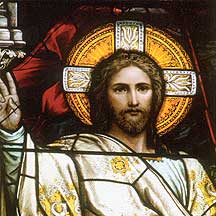
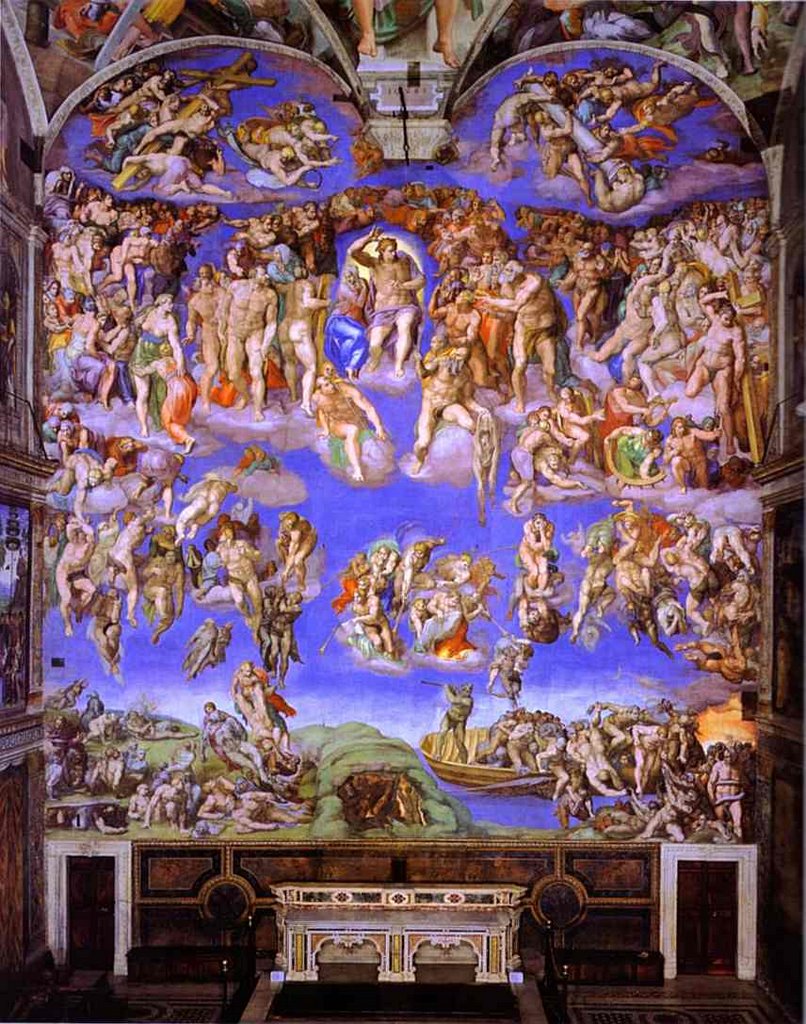


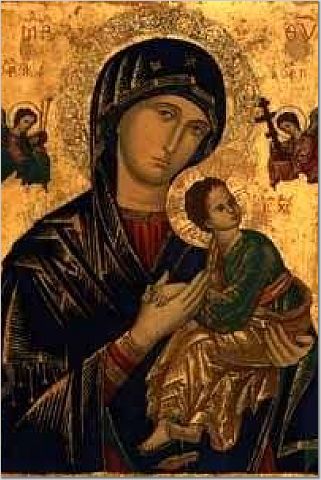



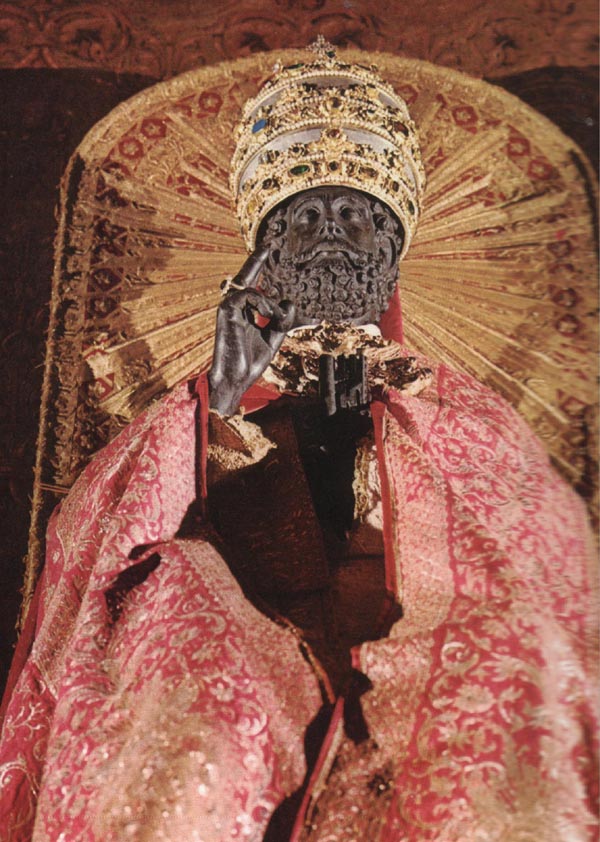
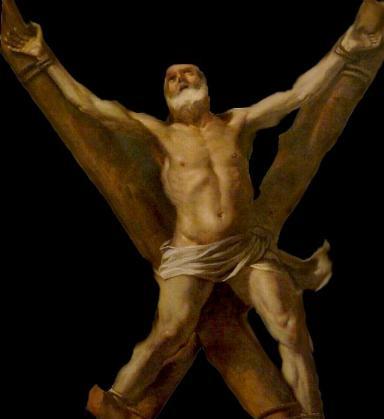

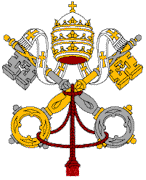


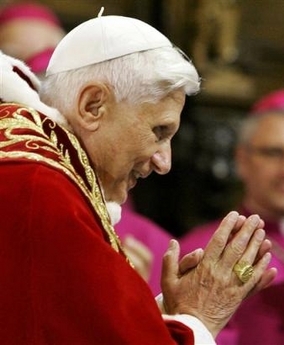






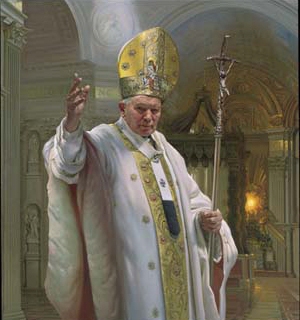
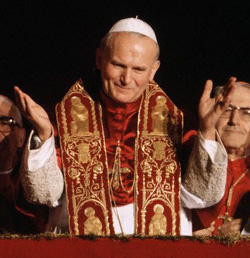
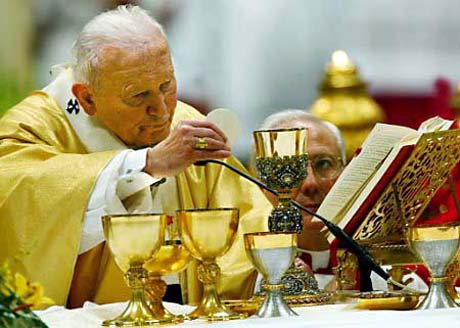
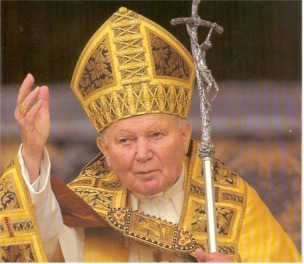






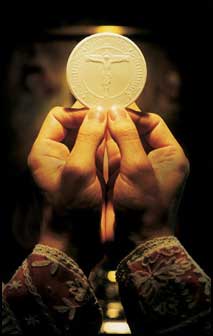
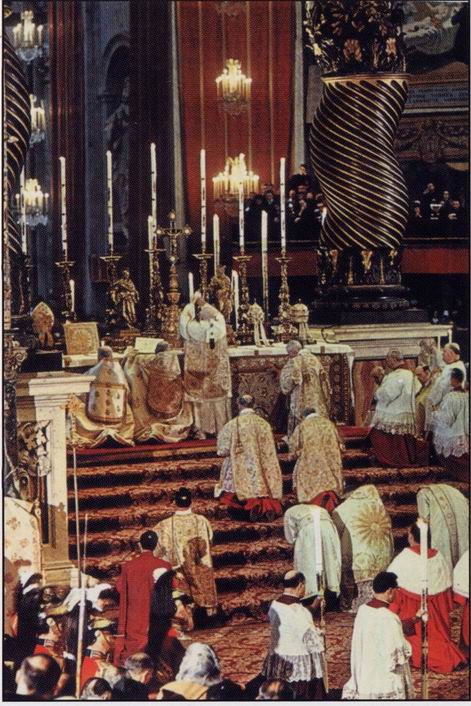

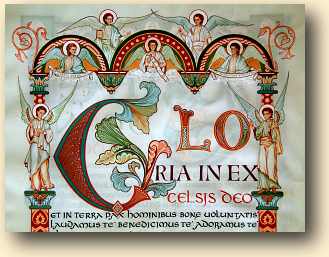

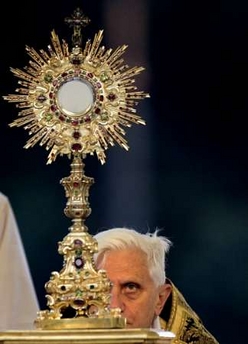


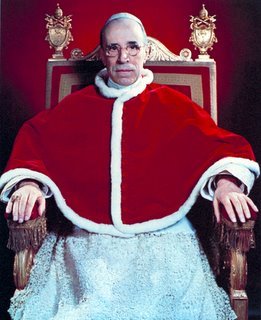




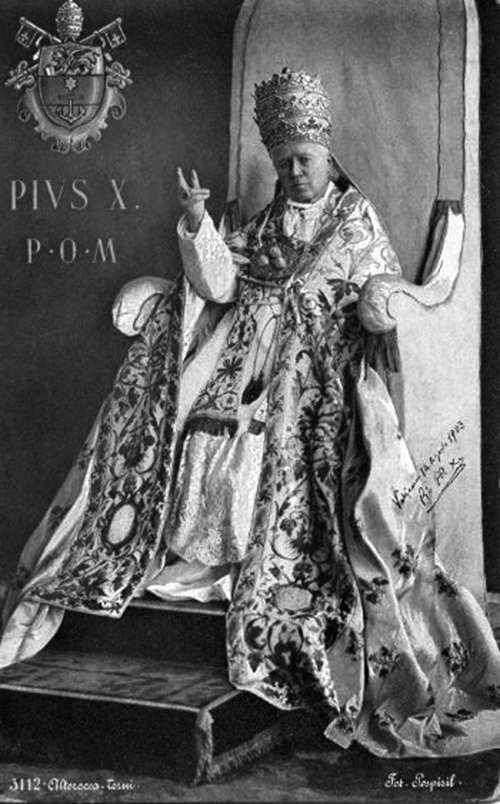



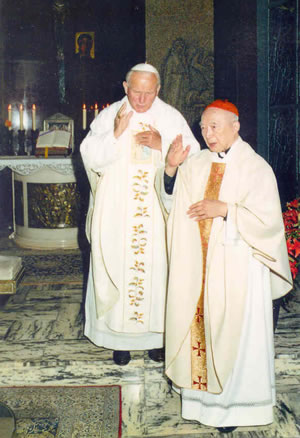






10 comments:
Nice work on the Jesuits. I'm considering passing this to the Regional Superior when I see him next. I'll be quick to say that there are one or 2 flakes in the PJ community, but thankfully its not as bad as it is in the States,where some have virtually denied most, if not all, of the Nicene Creed, which I personally believe is more dangerous.
ps: I'd love to see Fr. Kolvenbach celebrate the Armenian Rite upon retirement and I would definitely love to see if he becomes Archimandrite. He's one of a few Eastern-Rite Jesuits worth watching. The other is Robert Taft.
Excellent post Andrew. This is certainly a good time for the Jesuits to find themselves again. The days of mandala colouring-in must end, the order has been emasculated.
My prayers are on their way!
Many thanks to Andrew for this fascinating post.
The photos of the statue of St. Ignatius in the Gesu are very fine.
Andrea Pozzo is one of the great masters of the Baroque. His dramatic altarpiece in the Gesu is truly magnificent.
I hope and pray the Jesuits will one day recover their original spirituality.
The Church needs it.
Excellent post. Thorough research.
Where did you get the picture of St. Bellarmine?
Can I use it?
Keep up the good work!
Collin, my regards to Fr. Larry. And I happen to like Robert Taft and support his views on the erection of a Greek Catholic Patriarchate in the Ukraine.
John Michael, feel free to use anything you see in these pages.
Again, I feel like the Jesuits are such a great and inspired idea. It's a shame where they find themselves now, and most of it is by their own doing. All we can do is pray. And pray that should they continue down this path, a reformed Jesuit order may come forth in the model of the Franciscans(?).
Deo volente.
Andrew,
I am so impressed by your blog and this magnificent post. I will look for more great article and insights.
JMJ
Joe
Thanks for this post.
I find it interesting the most famous statue at Il Gesu is "The Triumph of Faith Over Heresy."
AMDG,
-J.
Perhaps one solution would be an Ecclesia Dei community in the Jesuit tradition - an equivalent to the Dominican Society of St Vincent Ferrer.
Well, most Ukrainian Catholics (and Russian Catholics) already refer to Cardinal Lubomyr Husar as "Patriarch of Kyiv, Halych, and All Rus".
Anyways, here is a surprise... A Greek-Catholic Divine Liturgy in Singapore which I attended in September 2007. Enjoy the video links (in the closest order possible to the Divine Liturgy)!
http://youtube.com/watch?v=ZKZxS8qaJSY&feature=related
http://youtube.com/watch?v=ZR9JPd49q3s&feature=related
http://youtube.com/watch?v=Q7YssKGIiUM&feature=related
http://youtube.com/watch?v=lnAAl_ZZWog&feature=related
http://youtube.com/watch?v=5CYKTZq-CEM&feature=related
http://youtube.com/watch?v=zKAW9q9SJdo&feature=related
http://youtube.com/watch?v=Zi_Ym0KtYnc&feature=related
When is Wlodimir Ledochowski going to get his due credit?
http://continuingcounterreformation.blogspot.com/2009/11/along-amber-path-7_7355.html
Post a Comment